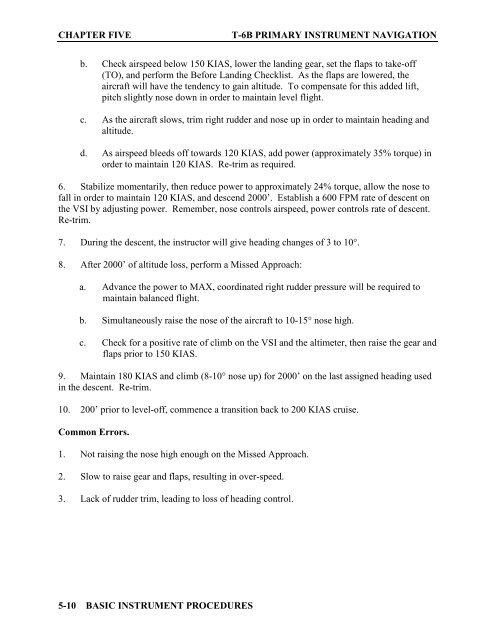Flight Training Instruction - Cnatra - U.S. Navy
Flight Training Instruction - Cnatra - U.S. Navy
Flight Training Instruction - Cnatra - U.S. Navy
Create successful ePaper yourself
Turn your PDF publications into a flip-book with our unique Google optimized e-Paper software.
CHAPTER FIVE T-6B PRIMARY INSTRUMENT NAVIGATION<br />
b. Check airspeed below 150 KIAS, lower the landing gear, set the flaps to take-off<br />
(TO), and perform the Before Landing Checklist. As the flaps are lowered, the<br />
aircraft will have the tendency to gain altitude. To compensate for this added lift,<br />
pitch slightly nose down in order to maintain level flight.<br />
c. As the aircraft slows, trim right rudder and nose up in order to maintain heading and<br />
altitude.<br />
d. As airspeed bleeds off towards 120 KIAS, add power (approximately 35% torque) in<br />
order to maintain 120 KIAS. Re-trim as required.<br />
6. Stabilize momentarily, then reduce power to approximately 24% torque, allow the nose to<br />
fall in order to maintain 120 KIAS, and descend 2000’. Establish a 600 FPM rate of descent on<br />
the VSI by adjusting power. Remember, nose controls airspeed, power controls rate of descent.<br />
Re-trim.<br />
7. During the descent, the instructor will give heading changes of 3 to 10°.<br />
8. After 2000’ of altitude loss, perform a Missed Approach:<br />
a. Advance the power to MAX, coordinated right rudder pressure will be required to<br />
maintain balanced flight.<br />
b. Simultaneously raise the nose of the aircraft to 10-15° nose high.<br />
c. Check for a positive rate of climb on the VSI and the altimeter, then raise the gear and<br />
flaps prior to 150 KIAS.<br />
9. Maintain 180 KIAS and climb (8-10° nose up) for 2000’ on the last assigned heading used<br />
in the descent. Re-trim.<br />
10. 200’ prior to level-off, commence a transition back to 200 KIAS cruise.<br />
Common Errors.<br />
1. Not raising the nose high enough on the Missed Approach.<br />
2. Slow to raise gear and flaps, resulting in over-speed.<br />
3. Lack of rudder trim, leading to loss of heading control.<br />
5-10 BASIC INSTRUMENT PROCEDURES
















